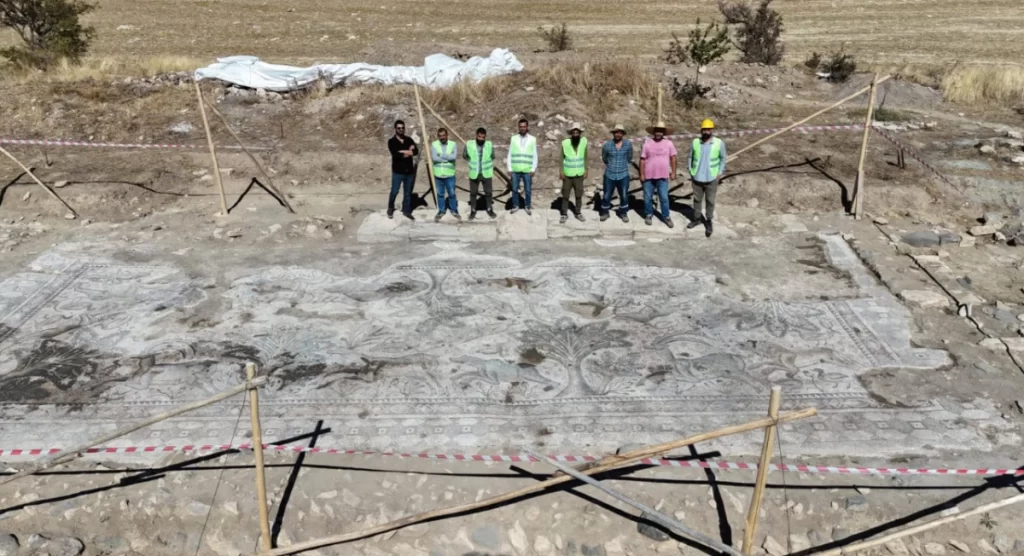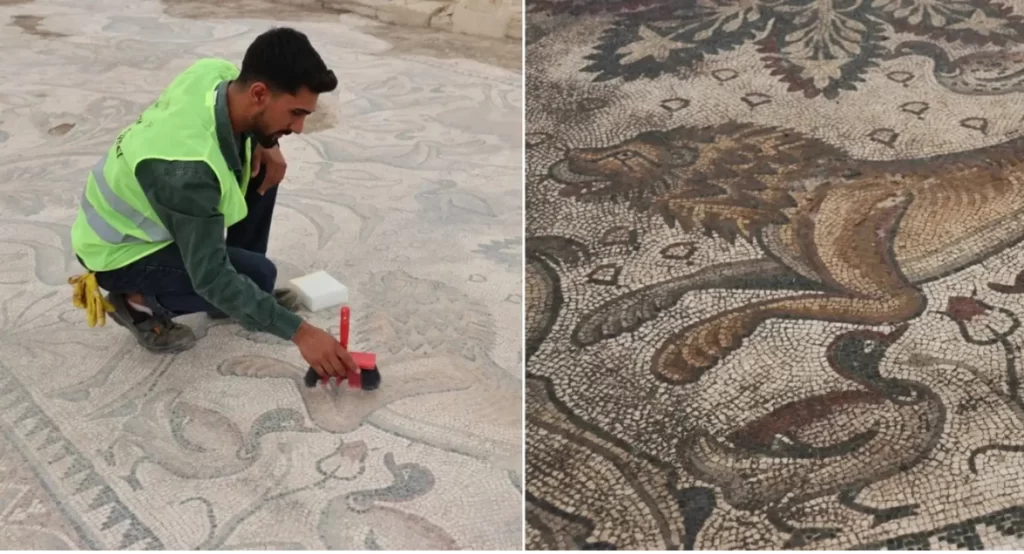Turkish Farmer Discovers Roman Mosaic
A Turkish farmer has recently stumbled upon a mosaic depicting an ancient hunting scene. Dating back to the late Roman era, the mosaic might represent the first of its kind discovered in Turkey. The discovery was made in September 2023 when while planting an orchard in eastern Turkey, Mehmet Emin Sualp, a farmer unearthed a large, well-preserved mosaic. When Sualp dug holes for cherry saplings on his newly purchased land in April 2023, he discovered the mosaic tiles buried under 50 cm of loose soil.
Upon uncovering the Roman mosaic, he informed Elazığ Archaeology and Ethnography Museum.
Emre Çayır on the Discovery
According to Emre Çayır, the lead archaeologist at the excavation, The Salkaya mosaic “is the first of its kind to have survived to the present day and in its portrayal of animals, all of which were once found here. There may be larger mosaics elsewhere in Turkey, but those consist of geometric patterns or mythological subjects. The lion and bear represent authority in the Roman tradition, and the depiction of hunting dogs reminds us that humans are part of the food chain, [showing how] the craftsmen used metaphor to convey these ideas.”
What Makes This Mosaic an Important Discovery?
Despite being discovered in 2023, it was not until this year that conservators unearthed the entire soil layer and the remains of a burned wooden roof that had collapsed over the site, which Emre Çayır attributes to the preservation of the tiles for so long. Investigations suggest that the Roman mosaic dates back to the late 3rd century, originating from an unknown settlement close to the village of Salkaya in Elazığ province, approximately 500 Km east of Ankara.

A surface survey has revealed several structures, including a bathhouse and a potential cult worship chamber, spread across 65,000 m2. Çayır and his team have also excavated a basalt road, an irrigation channel, and what seems to be a calcatorium used for winemaking. The coins discovered during the survey trace back to the late Roman and early Byzantine periods, leading archaeologists to estimate that the site has been occupied for approximately 1,600 to 1,700 years, although ceramic fragments found 2 meters deep suggest even an earlier habitation.
What does the Roman Mosaic Portray?
Covering an area of 84 m2, the Roman mosaic narrates various hunting sequences aligned along a north-south direction. A lion hunts a mountain goat, and a bear pursues a stag. The rare Anatolian leopard bites into an ostrich’s neck, while fierce greyhounds in collars encircle a wild boar. Birds like pheasants, ducks, geese, and partridges are depicted resting beside blooming roses or under pomegranate trees, providing serene intervals amidst the dynamic hunting scenes that unfold throughout the rectangular design “as a reflection of the eternal cycle of nature,” according to Çayır.
The natural elements, including flora and fauna, are framed by geometric designs using squares, triangles, and ellipses that seamlessly lead into the central scenes. The careful shading on the animals highlights their tensed muscles and shadows, while numerous details of flowers and birds throughout the tableau suggest that highly skilled mosaic artisans meticulously crafted this Roman mosaic.
What Does This Discovery Tell About the Ancient Civilization?
The discovery has baffled the archaeologists. The settlement could have served as a farming community or an outpost situated near the turbulent frontier between Rome and ancient Iran’s Sasanian Empire. Emre Çayır speculates that the mosaic functioned as “a display of power” and might have adorned a reception area or dining space in a Roman official’s residence, such as that of a governor or a military commander, before the region eventually came under Persian dominance.

What Happens Next?
Turkish authorities have yet to determine if the mosaic, the sole one discovered in Elazığ, should be relocated to the state museum or if a complex should be constructed at the site to preserve it in its original location. This decision will be contingent on the findings of any additional artefacts, as described by provincial governor Numan Hatipoğlu.
Image Courtesy – Euronews.com
Contributor





